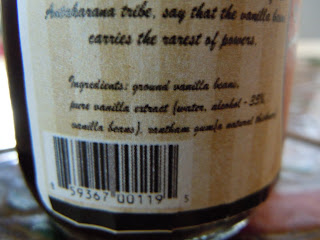I love vanilla in all of its forms.
For more than a decade, my favorite vanilla product has been high quality paste, caviar-like in its appearance, with a gorgeous bouquet. I use it in gelati, sorbets, cakes and all types of desserts. Adán has been using it in wonderful savory sauces.
Many of my friends and acquaintances swear by the Nielsen-Massey brand. I see it on television food shows, its label partly obscured so as not to promote but its pedigree unmistakable. It is the go-to brand for many. I decided to buy a bottle to try it, just to see how it compared with my own go-to brand, the Totonac line of products from Arizona Vanilla Company.
Both jars of paste are 4 ounces. The Nielsen-Massey was a little less expensive, $10.99 at Fante's. The Totonac is $15.95 online (though Arizona Vanilla sometimes has sales). For comparison, I used the Nielsen-Massey in a batch of vanilla-cinnamon gelato.
The two pastes differ widely in appearance. The Totonac is a true paste - thick and quite opaque. It can pour, but very slowly. By contrast, I was surprised to see that the Nielsen-Massey was more like a syrup - runny and transparent with visible specks of vanilla dispersed throughout. Its fragrance was not nearly as strong as that of the Totonac, and I had to use considerably more of the Nielsen-Massey to get a good vanilla flavor in my gelato. I was quite unimpressed with it. When I examined the labels, I understood why.
The ingredients list on my Totonac vanilla paste reads: "ground vanilla beans, pure vanilla extract (water, alcohol 35%, vanilla beans), xantham gum (a natural thickener)."
The Nielsen-Massey list reads: "sugar, water, vanilla extract, vanilla beans, gum tragacanth (a natural thickener)."
By law, ingredients must be listed on the label in order of quantity, with the the ingredient making up the largest quantity of all the ingredients listed first and the smallest quantity listed last.
So, the famous vanilla paste that all my friends swear by is basically sugar water with vanilla in it! My 4-ounce jar was exhausted in about a week and I happily returned to my tried and true Totonac. Lesson learned.
¡Buen provecho!
UPDATE September 2016 - Arizona Vanilla has ceased operations. After an extensive search, I am thrilled to report that I have found a new supplier and their products are as good as AV's or better. Their prices are actually better than AV's. I'm now using THE VANILLA COMPANY (www.vanillaqueen.com). Their paste is thicker and better-tasting than AV's. (NOTE: Don't faint when you see current vanilla prices. There's been a combination of factors in all the world's vanilla growing regions and prices have skyrocketed across the board. I just paid $240 for a gallon of double-fold Madagascar extract ... plus shipping. It's still better than using the cheap stuff - you use less and don't sacrifice flavor quality.)
For more than a decade, my favorite vanilla product has been high quality paste, caviar-like in its appearance, with a gorgeous bouquet. I use it in gelati, sorbets, cakes and all types of desserts. Adán has been using it in wonderful savory sauces.
Many of my friends and acquaintances swear by the Nielsen-Massey brand. I see it on television food shows, its label partly obscured so as not to promote but its pedigree unmistakable. It is the go-to brand for many. I decided to buy a bottle to try it, just to see how it compared with my own go-to brand, the Totonac line of products from Arizona Vanilla Company.
Both jars of paste are 4 ounces. The Nielsen-Massey was a little less expensive, $10.99 at Fante's. The Totonac is $15.95 online (though Arizona Vanilla sometimes has sales). For comparison, I used the Nielsen-Massey in a batch of vanilla-cinnamon gelato.
The two pastes differ widely in appearance. The Totonac is a true paste - thick and quite opaque. It can pour, but very slowly. By contrast, I was surprised to see that the Nielsen-Massey was more like a syrup - runny and transparent with visible specks of vanilla dispersed throughout. Its fragrance was not nearly as strong as that of the Totonac, and I had to use considerably more of the Nielsen-Massey to get a good vanilla flavor in my gelato. I was quite unimpressed with it. When I examined the labels, I understood why.
The ingredients list on my Totonac vanilla paste reads: "ground vanilla beans, pure vanilla extract (water, alcohol 35%, vanilla beans), xantham gum (a natural thickener)."
The Nielsen-Massey list reads: "sugar, water, vanilla extract, vanilla beans, gum tragacanth (a natural thickener)."
By law, ingredients must be listed on the label in order of quantity, with the the ingredient making up the largest quantity of all the ingredients listed first and the smallest quantity listed last.
So, the famous vanilla paste that all my friends swear by is basically sugar water with vanilla in it! My 4-ounce jar was exhausted in about a week and I happily returned to my tried and true Totonac. Lesson learned.
¡Buen provecho!
UPDATE September 2016 - Arizona Vanilla has ceased operations. After an extensive search, I am thrilled to report that I have found a new supplier and their products are as good as AV's or better. Their prices are actually better than AV's. I'm now using THE VANILLA COMPANY (www.vanillaqueen.com). Their paste is thicker and better-tasting than AV's. (NOTE: Don't faint when you see current vanilla prices. There's been a combination of factors in all the world's vanilla growing regions and prices have skyrocketed across the board. I just paid $240 for a gallon of double-fold Madagascar extract ... plus shipping. It's still better than using the cheap stuff - you use less and don't sacrifice flavor quality.)






